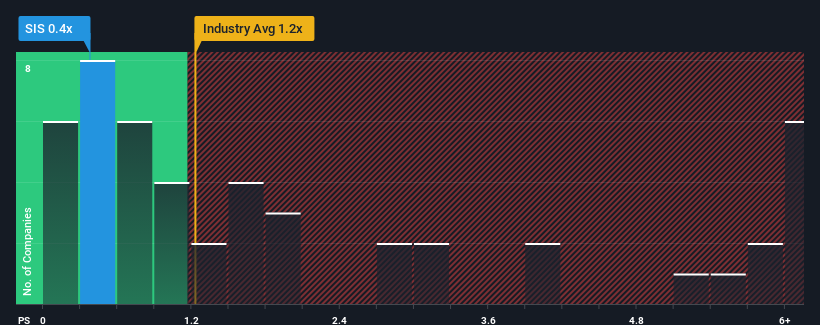- United Kingdom
- /
- Personal Products
- /
- AIM:SIS
Science in Sport plc (LON:SIS) Might Not Be As Mispriced As It Looks

With a price-to-sales (or "P/S") ratio of 0.4x Science in Sport plc (LON:SIS) may be sending bullish signals at the moment, given that almost half of all the Personal Products companies in the United Kingdom have P/S ratios greater than 1.8x and even P/S higher than 5x are not unusual. Although, it's not wise to just take the P/S at face value as there may be an explanation why it's limited.
See our latest analysis for Science in Sport

How Has Science in Sport Performed Recently?
Recent times haven't been great for Science in Sport as its revenue has been rising slower than most other companies. Perhaps the market is expecting the current trend of poor revenue growth to continue, which has kept the P/S suppressed. If you still like the company, you'd be hoping revenue doesn't get any worse and that you could pick up some stock while it's out of favour.
Want the full picture on analyst estimates for the company? Then our free report on Science in Sport will help you uncover what's on the horizon.What Are Revenue Growth Metrics Telling Us About The Low P/S?
There's an inherent assumption that a company should underperform the industry for P/S ratios like Science in Sport's to be considered reasonable.
Retrospectively, the last year delivered virtually the same number to the company's top line as the year before. Still, the latest three year period has seen an excellent 34% overall rise in revenue, in spite of its uninspiring short-term performance. Accordingly, shareholders will be pleased, but also have some questions to ponder about the last 12 months.
Shifting to the future, estimates from the lone analyst covering the company suggest revenue should grow by 15% over the next year. With the industry only predicted to deliver 0.5%, the company is positioned for a stronger revenue result.
With this information, we find it odd that Science in Sport is trading at a P/S lower than the industry. It looks like most investors are not convinced at all that the company can achieve future growth expectations.
The Final Word
We'd say the price-to-sales ratio's power isn't primarily as a valuation instrument but rather to gauge current investor sentiment and future expectations.
To us, it seems Science in Sport currently trades on a significantly depressed P/S given its forecasted revenue growth is higher than the rest of its industry. There could be some major risk factors that are placing downward pressure on the P/S ratio. It appears the market could be anticipating revenue instability, because these conditions should normally provide a boost to the share price.
Before you take the next step, you should know about the 4 warning signs for Science in Sport (1 is a bit concerning!) that we have uncovered.
If companies with solid past earnings growth is up your alley, you may wish to see this free collection of other companies with strong earnings growth and low P/E ratios.
New: Manage All Your Stock Portfolios in One Place
We've created the ultimate portfolio companion for stock investors, and it's free.
• Connect an unlimited number of Portfolios and see your total in one currency
• Be alerted to new Warning Signs or Risks via email or mobile
• Track the Fair Value of your stocks
Have feedback on this article? Concerned about the content? Get in touch with us directly. Alternatively, email editorial-team (at) simplywallst.com.
This article by Simply Wall St is general in nature. We provide commentary based on historical data and analyst forecasts only using an unbiased methodology and our articles are not intended to be financial advice. It does not constitute a recommendation to buy or sell any stock, and does not take account of your objectives, or your financial situation. We aim to bring you long-term focused analysis driven by fundamental data. Note that our analysis may not factor in the latest price-sensitive company announcements or qualitative material. Simply Wall St has no position in any stocks mentioned.
About AIM:SIS
Science in Sport
Develops, manufactures, and markets sports nutrition products for professional athletes, sports and fitness enthusiasts, and the active lifestyle community in the United Kingdom, rest of Europe, the United States, and internationally.
Adequate balance sheet low.

